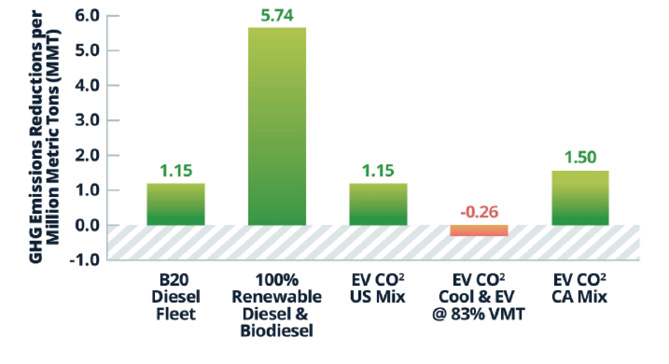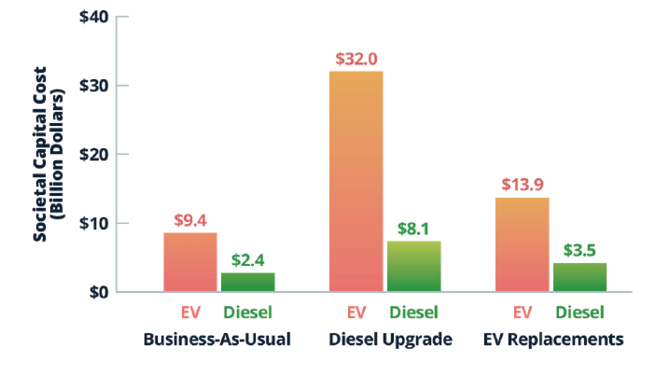
Stillwater Associates researchers chart the prospective GHG emissions savings attending diesel truck fleets running with fuel flexibility versus electric vehicle alternatives.
A new study that evaluates several approaches to reducing greenhouse gas (GHG) and other emissions from medium- and heavy-duty vehicles over the next decade finds considerable advantages with advanced diesel technology—particularly when using renewable biofuels—as compared to an electrification strategy.
Trucks operating in 10 Northeastern states (Connecticut, Delaware, Massachusetts, Maryland, Maine, New Jersey, New York, Pennsylvania, Rhode Island, and Vermont) that have adopted California’s low emission (LEV) and zero emission vehicle (ZEV) regulations were studied by Stillwater Associates for the Diesel Technology Forum, Washington, D.C. An analysis was undertaken to analyze the environmental benefits attainable from three strategies in the 2022-2032 period: Electrification, accelerated fleet turnover, and use of biodiesel and renewable diesel fuel.
“As we look for the best ways to reduce greenhouse gas and other emissions, this study demonstrates that accelerating fleet turnover and use of renewable and biodiesel fuels can deliver significantly more benefits (3X) that outweigh those possible from electric vehicles (EV) in the region in the study period. Advanced diesel technology is more effective, more affordable, and most importantly more available than others,” says Forum Executive Director Allen Schaeffer. “The urgency to implement solutions to reduce greenhouse gases from transportation is heard on a daily basis. Transitions to new energy sources still have considerable uncertainties and longer timeframes—a decade or more—to meaningful implementation. Some solutions will be available sooner than others and at larger scale than others. Advanced diesel technology, as well as renewable and biodiesel fuels, are key available solutions that can deliver big impacts today.”

The considerable benefits of using low-carbon renewable biobased diesel fuels becomes clearer from this analysis, he adds. Running the diesel vehicles in the study with 100 percent renewable diesel resulted in three times larger cumulative GHG reductions by 2032 than the EV scenarios. Using B20, a 20/80 blend of biodiesel and petroleum diesel, provided about the same cumulative GHG reduction.
“All eyes seem to be focused on electrification as the best if not the only strategy for future fuel and technology in the transportation sector. This work has illuminated that’s overly simplistic; that there are significant, less expensive and more available emissions reduction strategies for these workhorse vehicles which can enable greater emission reductions to be delivered more rapidly,” affirms Stillwater Associates Automotive Engineer Gary Yowell.
Beyond GHG emissions, the research also highlights impacts of an advanced diesel vs. electrification strategy on regional air quality as well, finding that the business-as-usual case replacing pre-2007 model year diesel vehicles which lacked diesel particulate filters with advanced technology diesel vehicles provided the largest particulate matter (PM) reduction. This is due to new technology diesel engines’ 98 percent PM reductions compared to EVs’ 95 percent PM reduction assuming power from the U.S. Grid Mix. As for nitrogen oxides (NOx) emissions, EVs have 98.5 percent lower NOx than pre-2007 diesel vehicles on a per mile basis, and 2010 and later MY vehicles have 79 percent less NOx emissions than a 2007 diesel model. However, when replacing a diesel medium- or heavy-duty vehicle with an EV and evaluated on an annual miles driven basis, the NOx benefit is diminished.
EVs are generally deployed on shorter routes and have a shorter range of operation than that of a comparable diesel vehicle, with about 87 percent of the mileage on a daily basis. Given this mileage difference, NOx emission reductions for a fleet transitioning to EV will be less than the business-as-usual turnover from older generation diesel to advanced technology with selective catalytic reduction systems that reduce NOx by 98 percent.
On a cumulative fleet conversion cost basis, turning over a medium- and heavyduty fleet of 10,000 vehicles in the region over to EV carries a price tag more than three times higher than the equivalent cost for new technology diesel vehicles. The incremental EV cost for Class 7/8 vehicles is $250,000 for the vehicle and $45,000 for charging infrastructure.